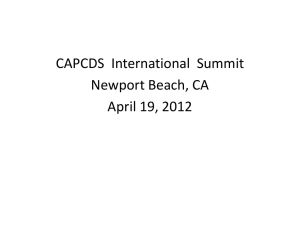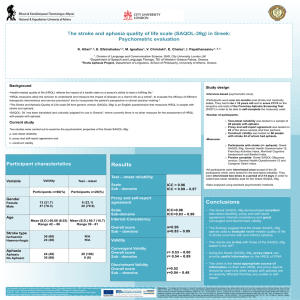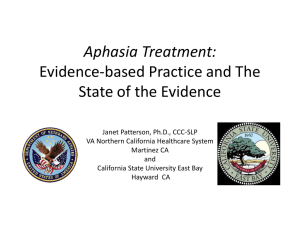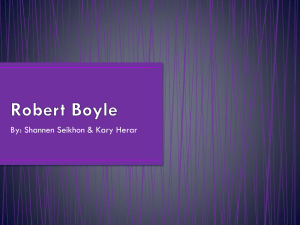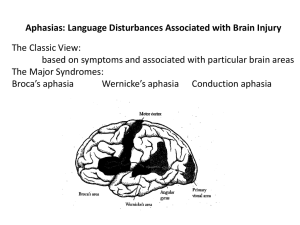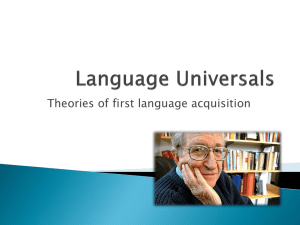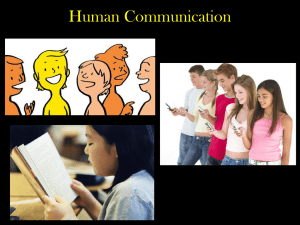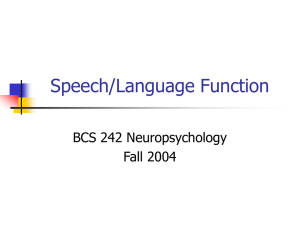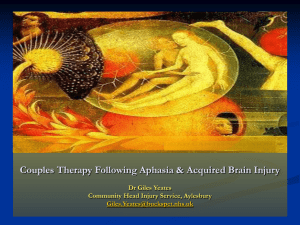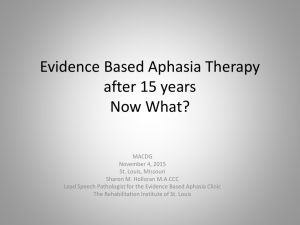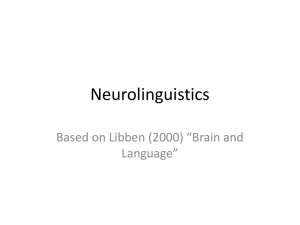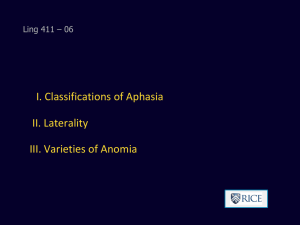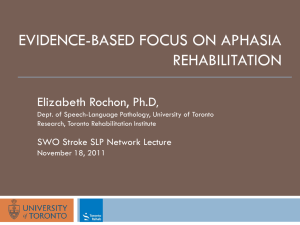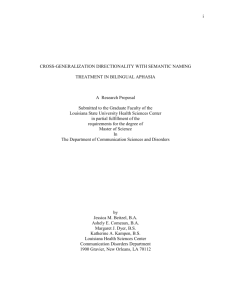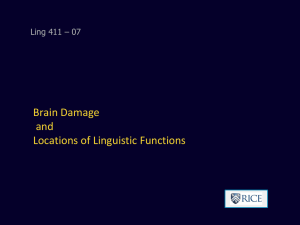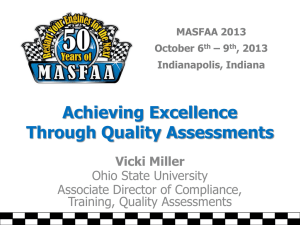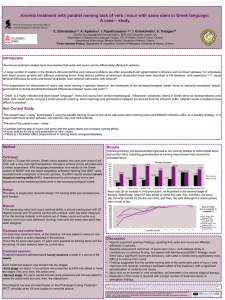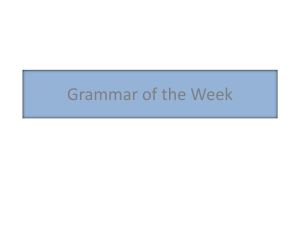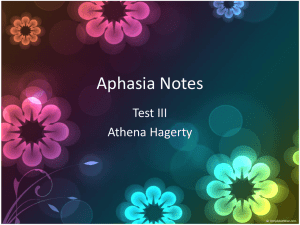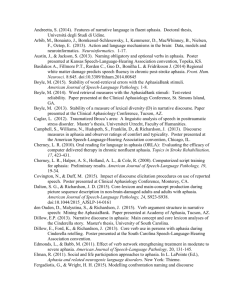Elaborated Semantic Feature Analysis Treatment for Anomia
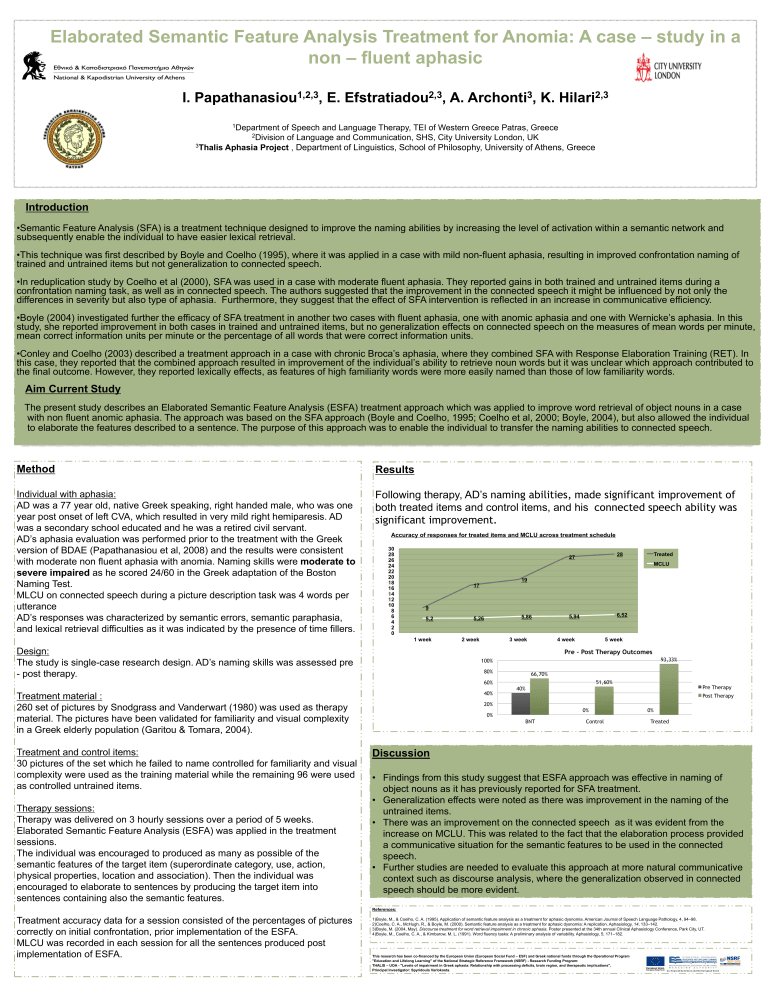
Elaborated Semantic Feature Analysis Treatment for Anomia: A case – study in a non – fluent aphasic
I. Papathanasiou
1,2,3
, E. Efstratiadou
2,3
, A. Archonti
3
, K. Hilari
2,3
1
Department of Speech and Language Therapy, TEI of Western Greece Patras, Greece
2
Division of Language and Communication, SHS, City University London, UK
3
Thalis Aphasia Project , Department of Linguistics, School of Philosophy, University of Athens, Greece
Introduction
•Semantic Feature Analysis (SFA) is a treatment technique designed to improve the naming abilities by increasing the level of activation within a semantic network and subsequently enable the individual to have easier lexical retrieval.
•This technique was first described by Boyle and Coelho (1995), where it was applied in a case with mild non-fluent aphasia, resulting in improved confrontation naming of trained and untrained items but not generalization to connected speech.
•In reduplication study by Coelho et al (2000), SFA was used in a case with moderate fluent aphasia. They reported gains in both trained and untrained items during a confrontation naming task, as well as in connected speech. The authors suggested that the improvement in the connected speech it might be influenced by not only the differences in severity but also type of aphasia. Furthermore, they suggest that the effect of SFA intervention is reflected in an increase in communicative efficiency.
•Boyle (2004) investigated further the efficacy of SFA treatment in another two cases with fluent aphasia, one with anomic aphasia and one with Wernicke’s aphasia. In this study, she reported improvement in both cases in trained and untrained items, but no generalization effects on connected speech on the measures of mean words per minute, mean correct information units per minute or the percentage of all words that were correct information units.
•Conley and Coelho (2003) described a treatment approach in a case with chronic Broca’s aphasia, where they combined SFA with Response Elaboration Training (RET). In this case, they reported that the combined approach resulted in improvement of the individual ’s ability to retrieve noun words but it was unclear which approach contributed to the final outcome. However, they reported lexically effects, as features of high familiarity words were more easily named than those of low familiarity words.
Aim Current Study
The present study describes an Elaborated Semantic Feature Analysis (ESFA) treatment approach which was applied to improve word retrieval of object nouns in a case with non fluent anomic aphasia. The approach was based on the SFA approach (Boyle and Coelho, 1995; Coelho et al, 2000; Boyle, 2004), but also allowed the individual to elaborate the features described to a sentence. The purpose of this approach was to enable the individual to transfer the naming abilities to connected speech.
Method
Individual with aphasia:
AD was a 77 year old, native Greek speaking, right handed male, who was one year post onset of left CVA, which resulted in very mild right hemiparesis. AD was a secondary school educated and he was a retired civil servant.
AD ’s aphasia evaluation was performed prior to the treatment with the Greek version of BDAE (Papathanasiou et al, 2008) and the results were consistent with moderate non fluent aphasia with anomia. Naming skills were moderate to severe impaired as he scored 24/60 in the Greek adaptation of the Boston
Naming Test.
MLCU on connected speech during a picture description task was 4 words per utterance
AD ’s responses was characterized by semantic errors, semantic paraphasia, and lexical retrieval difficulties as it was indicated by the presence of time fillers.
Design:
The study is single-case research design. AD ’s naming skills was assessed pre
- post therapy.
Treatment material :
260 set of pictures by Snodgrass and Vanderwart (1980) was used as therapy material. The pictures have been validated for familiarity and visual complexity in a Greek elderly population (Garitou & Tomara, 2004).
Results
Following therapy, AD ’s naming abilities, made significant improvement of both treated items and control items, and his significant improvement. connected speech ability was
Treatment and control items:
30 pictures of the set which he failed to name controlled for familiarity and visual complexity were used as the training material while the remaining 96 were used as controlled untrained items.
Therapy sessions:
Therapy was delivered on 3 hourly sessions over a period of 5 weeks.
Elaborated Semantic Feature Analysis (ESFA) was applied in the treatment sessions.
The individual was encouraged to produced as many as possible of the semantic features of the target item (superordinate category, use, action, physical properties, location and association). Then the individual was encouraged to elaborate to sentences by producing the target item into sentences containing also the semantic features.
Discussion
• Findings from this study suggest that ESFA approach was effective in naming of object nouns as it has previously reported for SFA treatment.
• Generalization effects were noted as there was improvement in the naming of the untrained items.
• There was an improvement on the connected speech as it was evident from the increase on MCLU. This was related to the fact that the elaboration process provided a communicative situation for the semantic features to be used in the connected speech.
• Further studies are needed to evaluate this approach at more natural communicative context such as discourse analysis, where the generalization observed in connected speech should be more evident.
Treatment accuracy data for a session consisted of the percentages of pictures correctly on initial confrontation, prior implementation of the ESFA.
MLCU was recorded in each session for all the sentences produced post implementation of ESFA.
References:
1)Boyle, M., & Coelho, C. A. (1995). Application of semantic feature analysis as a treatment for aphasic dysnomia. American Journal of Speech Language Pathology, 4, 94 –98.
2)Coelho, C. A., McHugh, R., & Boyle, M. (2000). Semantic feature analysis as a treatment for aphasic dysnomia: A replication. Aphasiology, 14 , 133 –142.
3)Boyle, M. (2004, May). Discourse treatment for word retrieval impairment in chronic aphasia. Poster presented at the 34th annual Clinical Aphasiology Conference, Park City, UT.
4)Boyle, M., Coelho, C. A., & Kimbarow, M. L. (1991). Word fluency tasks: A preliminary analysis of variability. Aphasiology, 5, 171 –182.
This research has been co-financed by the European Union (European Social Fund
– ESF) and Greek national funds through the Operational Program
"Education and Lifelong Learning" of the National Strategic Reference Framework (NSRF) - Research Funding Program:
THALIS – UOA - "Levels of impairment in Greek aphasia: Relationship with processing deficits, brain region, and therapeutic implications",
Principal Investigator: Spyridoula Varlokosta.
